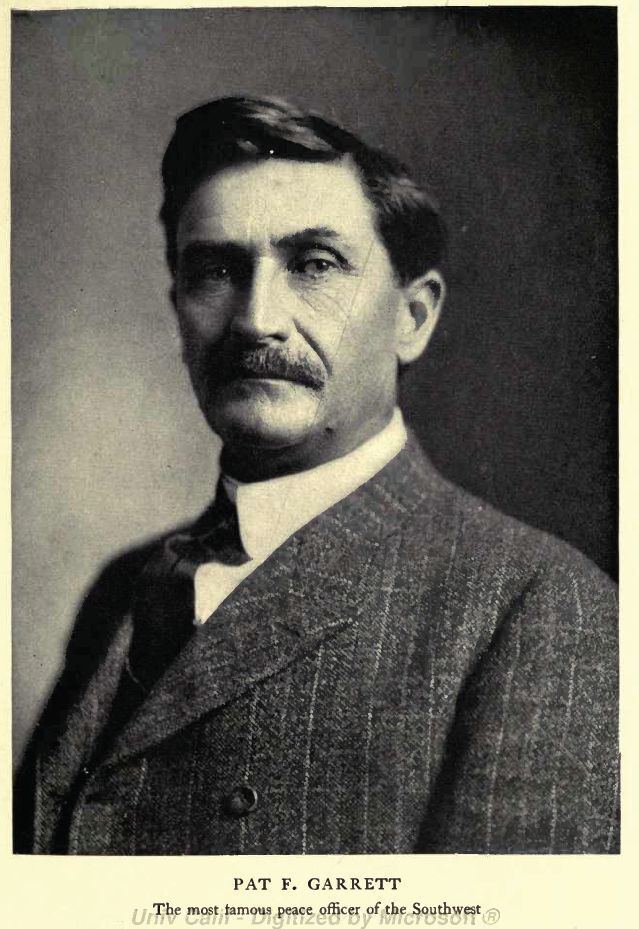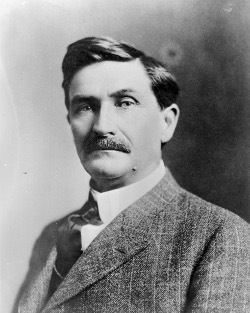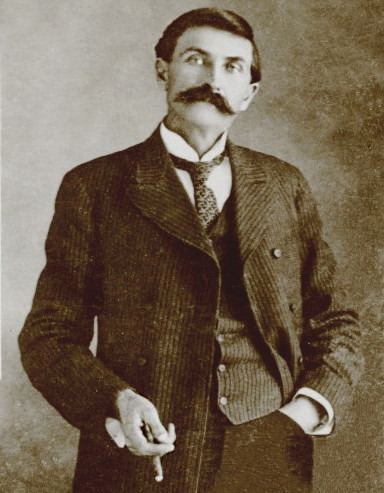Cause of death Shooting Name Pat Garrett Height 6 ft 5 in (1.96 m) | ||
 | ||
Resting place Masonic CemeteryLas Cruces, New Mexico32°18′4″N 106°47′7″W / 32.30111°N 106.78528°W / 32.30111; -106.78528 (Gravesite of Pat Garrett) Spouse Apolinaria Gutierrez Garrett (m. 1880–1908) Children Ida Dudley Poe Garrett, Elizabeth Garrett, Ida Garrett Parents Elizabeth A. Garrett, John L. Garrett Books The Authentic Life of Billy, the Kid, The Life of Billy the Kid, Authentic Story of Billy the Kid Similar People Billy the Kid, James Coburn, Brushy Bill Roberts, Wyatt Earp, Jesse James | ||
Other names Patrick Floyd Garrett | ||
Video Essay - Sheriff Baker's Death in Pat Garrett and Billy the Kid
Patrick Floyd Jarvis "Pat" Garrett (June 5, 1850 – February 29, 1908) was an American Old West lawman, bartender and customs agent who became renowned for killing Billy the Kid. He was the sheriff of Lincoln County, New Mexico as well as Doña Ana County, New Mexico. He co-authored a book about Billy the Kid which, for a generation after the Kid's death, was deemed authoritative; however, historians have since found many embellishments and inconsistencies with other accounts of the outlaw's life. Garrett was murdered under unclear circumstances.
Contents
- Video Essay Sheriff Bakers Death in Pat Garrett and Billy the Kid
- Knockin on heaven s door pat garrett billy the kid
- Early years
- Garretts life in the West
- The pursuit of Billy the Kid
- As a biographer
- Texas Ranger
- Later years
- Disappearance of Albert Jennings Fountain
- Final kill
- Presidential appointment in El Paso
- Financial problems
- Last conflict and death
- Who killed Pat Garrett
- Funeral and burial site
- Portrayals in film
- References

Knockin on heaven s door pat garrett billy the kid
Early years

Patrick Floyd Jarvis "Pat" Garrett was born on June 5, 1850, in Chambers County, Alabama. He was the second of five children born to John Lumpkin Garrett (1822–1868) and his wife Elizabeth Ann Jarvis (1829–1867). Pat's four siblings were named Margaret, Elizabeth, John and Alfred. When Pat was three years old his father purchased the John Greer plantation in Claiborne Parish, Louisiana. The Civil War destroyed the Garrett family's finances. Pat's mother died on March 25, 1867 at the age of 37. Less than a year later, on February 5, 1868, his father died at age 45. He and his siblings were left with a plantation that was more than $30,000 in debt. His brothers and sisters were taken in by relatives. With no reason to remain, 18-year-old Garrett rode away from Louisiana on January 25, 1869, heading west.
Garrett's life in the West

Garrett's whereabouts over the next seven years are obscure. By 1876 he was in Texas hunting buffalo. During this period Garrett killed his first man, another buffalo hunter named Joe Briscoe. Garrett surrendered to the authorities at Fort Griffin, Texas, but they declined to prosecute. When the buffalo hunting declined, Garrett left Texas and rode to the New Mexico Territory.

When Garrett arrived at Fort Sumner, New Mexico, he found work as a cowboy for Pedro Menard "Pete" Maxwell (1848–1898). He married to Juanita Gutierrez, who died giving birth to their child. He did not remain a widower long though, and on January 14, 1880, Garrett married Apolinaria Gutierrez (1862–1936), the 17-year-old sister of his first wife. Between 1881 and 1905 Apolinaria Garrett gave birth to eight children, named Ida, Dudley, Elizabeth, Annie, Patrick, Pauline, Oscar and Jarvis.
The pursuit of Billy the Kid
On November 2, 1880, Garrett was elected sheriff of Lincoln County, New Mexico, having defeated incumbent Sheriff George Kimball by a vote of 320 to 179. Although Garrett's term would not begin until January 1, 1881, he was eager to capture the fugitive William Bonney (better known as "Billy the Kid"), and persuaded Sheriff Kimball to appoint him a deputy sheriff for the remainder of Kimball's term. Garrett was further aided when he obtained a deputy U.S. Marshal's commission, which allowed him to pursue the Kid across county lines. Garrett and his posse stormed the Dedrick ranch at Bosque Grande on November 30, 1880. They expected to find the Kid there, but only succeeded in capturing John Joshua Webb, who had been charged with murder, along with an accused horse thief named George Davis. Garrett turned Webb and Davis over to the sheriff of San Miguel County a few days later, and moved on to the settlement of Puerto de Luna. There a local tough named Mariano Leiva picked a fight with Garrett and was shot in the shoulder.
On December 19, 1880, Billy the Kid, Charlie Bowdre, Tom Pickett, Billy Wilson and Tom O'Folliard rode into Fort Sumner. Lying in wait were deputy Garrett and his posse. Mistaking O'Folliard for the Kid, Garrett's men opened fire and killed O'Folliard; Billy the Kid and the others escaped unharmed. Three days later, Garrett's posse cornered the Kid and his companions at a spot called Stinking Springs. They killed one man and captured the others, including the Kid. On April 15, 1881, Billy the Kid was sentenced to hang by Judge Warren Bristol, but he escaped thirteen days later.
On July 14, 1881, Garrett visited Fort Sumner to question a friend of the Kid's about his whereabouts and learned he was staying with a mutual friend, Pedro Menard "Pete" Maxwell. Around midnight, Garrett went to Maxwell's house. The Kid was asleep in another part of the house, but woke up in the middle of the night and entered Maxwell's bedroom, where Garrett was standing in the shadows. The Kid did not recognize the man standing in the dark. He asked him, repeatedly, "¿Quién es?" (Who is it?), and Garrett replied by shooting at him twice. The first shot hit the Kid in the chest just above the heart, killing him.
As a biographer
Following Billy the Kid's death, writers quickly went to work producing books and articles that made a folk hero out of Billy the Kid, while making Garrett seem like an assassin. Garrett attempted to counter these writers by publishing a book of his own in 1882. The Authentic Life of Billy, the Kid was largely ghost-written by Garrett's friend Marshall Ashmun "Ash" Upson (1828–1894). A failure when originally released, an original copy of the Pat Garrett-Ash Upson book became a rare commodity; in 1969 the original 1882 edition of the Garrett-Upson book was described by Ramon F. Adams as being "exceedingly rare." Twentieth century editions of Garrett's Authentic Life of Billy, the Kid (with alterations to the original title) appeared in 1927, 1946 and 1964.
Texas Ranger
Garrett did not seek re-election as sheriff of Lincoln County in 1882. He moved to Texas where, on March 10, 1884, Governor John Ireland appointed him a Lieutenant in the Texas Rangers. Within a year, Pat resigned his commission and returned to his ranch near Roswell, New Mexico.
Later years
Garrett discovered a large reservoir of artesian water in the Roswell region and went into partnership with two men to organize the "Pecos Valley Irrigation and Investment Company" on July 18, 1885. Garrett kept his irrigation schemes alive for several years, and on January 15, 1887, he purchased a one-third interest in the "Texas Irrigation Ditch Company", but the partners got rid of him. On August 15, 1887 he formed a partnership with William L. Holloman in the "Holloman and Garrett Ditch Company." All of Garrett's forays into the irrigation field, however, resulted in failure.
By 1892 Garrett had moved his large family to Uvalde, Texas, where he became close friends with John Nance Garner (1868–1967), a future vice president of the United States.
Disappearance of Albert Jennings Fountain
Pat Garrett might have lived out the remainder of his life in Uvalde, Texas, had it not been for a headline-making event back in New Mexico. On January 31, 1896 Colonel Albert Jennings Fountain and his eight-year-old son Henry disappeared at the edge of the White Sands area of southern New Mexico. Neither of the Fountains was ever seen again. The Fountain mystery was never officially solved, even with the efforts of Apache scouts, the Pinkertons, and an all-out push by the Republican Party. In April 1896, Garrett was appointed sheriff of Dona Ana County, and two years later had gathered sufficient evidence to make arrests, asking a judge in Las Cruces for warrants to arrest Oliver M. Lee, William McNew, Bill Carr and James Gililland. Within hours, he had arrested McNew and Carr.
During the early morning hours of July 12, 1898 Garrett and his posse confronted Oliver M. Lee and James Gililland at a spot called "Wildy Well" near Orogrande, Texas. Garrett had hoped to capture the fugitives while they were sleeping, but Lee and Gililland expected trouble and took their bedrolls up to the roof of the bunkhouse to avoid being taken by surprise. One of Garrett's deputies named Kearney heard footsteps on the roof, scaled a ladder, and was mortally wounded by the fugitives. A stray shot nicked Garrett. Because of his concern for his dying deputy, Garrett arranged a truce with the fugitives and withdrew while Kearney was lifted into a wagon. Kearney, however, died on the road to Las Cruces, and Lee and Gililland remained at large for another eight months, before they finally surrendered to Sheriff George Curry. They were found not guilty in the Fountain killings, and the indictments for killing the deputy were also dismissed.
Final kill
Pat Garrett killed his last offender in 1899, a fugitive named Norman Newman, who was wanted for murder in Greer County, Oklahoma. Newman was hiding out at the San Augustin Ranch in New Mexico. Sheriff George Blalock of Greer County went to New Mexico and asked Garrett for his assistance. The lawmen and Jose Espalin, one of Garrett's deputies, rode to the ranch, and on October 7, 1899, Newman was killed in a gunfight.
Presidential appointment in El Paso
On December 16, 1901 President Theodore Roosevelt nominated Garrett to the post of collector of customs in El Paso. He also became one of President Roosevelt's three "White House Gunfighters" (Bat Masterson and Ben Daniels being the others).
Despite public outcry over his appointment, Garrett was confirmed by the U.S. Senate on January 2, 1902. Garrett's tenure as El Paso's collector of customs was stormy from the start. On May 8, 1903 he got into a public fistfight with an employee named George Gaither. The following morning, both Garrett and Gaither paid five dollar fines for disturbing the peace. Continued complaints about Garrett's alleged incompetence were sent to Washington. Through it all, President Roosevelt stood by Garrett. As a show of his support, Roosevelt invited Garrett to attend a "Rough Rider" reunion being held in San Antonio during April 1905. Since Garrett had not been a member of that regiment, Roosevelt's invitation was taken as a snub at those critics who wanted Garrett replaced from his post. Garrett brought a guest of his own to the event named Tom Powers. Garrett introduced Powers to the president as "a prominent Texas cattleman." Garrett and Powers posed for two photographs with Roosevelt, first standing with him in a group and later seated with Roosevelt at dinner. Garrett's enemies obtained copies of the photos and sent them to Roosevelt, informing the president that instead of being the "cattleman" that Garrett claimed, Powers was, in fact, the owner of a "notorious dive" in El Paso called the Coney Island Saloon. That was the final straw for Roosevelt, who replaced Garrett with a new collector of customs on January 2, 1906.
Financial problems
Following his dismissal, Garrett returned with his family to New Mexico. Garrett was in deep financial difficulty. His ranch had been heavily mortgaged, and when he was unable to make payments, the county auctioned off all of Garrett's personal possessions to satisfy judgments against him. The total from the auction came to only $650. President Roosevelt had appointed Pat's friend, George Curry as the territorial governor of New Mexico. Garrett met with Curry, who promised him the position of superintendent of the territorial prison at Santa Fe, once he was inaugurated. Since Curry's inauguration was still months away, the destitute Garrett left his family in New Mexico and returned to El Paso where he found employment with the real estate firm of H.M. Maple and Company. During this period Garrett moved in with a woman known as "Mrs. Brown", who was described as an El Paso prostitute. When Governor-elect Curry learned of his involvement with Brown, the promised appointment of prison superintendent was withdrawn.
Last conflict and death
Dudley Poe Garrett, Pat's son, had signed a five-year lease for his Bear Canyon Ranch with Jesse Wayne Brazel. Garrett and his son objected when Brazel began bringing in large herds of goats, which were anathema to cattlemen like Garrett. Garrett tried to break the lease when he learned that the money for Brazel's operation had been put up by his neighbor, W.W. "Bill" Cox. He was further angered when he learned that Archie Prentice "Print" Rhode was Brazel's partner in the huge goat herd. When Brazel refused, the matter went to court. At this point James B. Miller met with Garrett to try to solve the problem. Miller met with Brazel, who agreed to cancel his lease with Garrett – provided a buyer could be found for his herd of 1,200 goats. Carl Adamson, who was related to Miller by marriage, agreed to buy the 1,200 goats. Just when the matter seemed resolved, Brazel claimed that he had "miscounted" his goat herd, claiming there were actually 1,800 – rather than his previous estimate of 1,200. Adamson refused to buy that many goats, but agreed to meet with Garrett and Brazel to see if they could reach some sort of agreement.
Garrett and Carl Adamson rode together, heading from Las Cruces, New Mexico in Adamson's wagon. Brazel appeared on horseback along the way. Garrett was shot and killed, but exactly by whom remains the subject of controversy. Brazel and Adamson left the body by the side of the road and returned to Las Cruces, where Brazel surrendered to Deputy Sheriff Felipe Lucero. More than thirty years later, Lucero claimed that Brazel exclaimed, "Lock me up. I've just killed Pat Garrett!" Brazel then pointed to Adamson and said, "He saw the whole thing and knows that I shot in self-defense." Deputy Lucero incarcerated Brazel, summoned a coroner's jury, and rode to Pat Garrett's death site.
Brazel's trial for Garrett's murder concluded on May 4, 1909. Brazel was represented at his trial by attorney and future Secretary of the Interior Albert Bacon Fall. The only eye-witness to Garrett's murder, Adamson, never appeared at the trial, which lasted only one day and ended with an acquittal.
Who killed Pat Garrett?
Despite his confession, and subsequent trial, few historians are convinced that Brazel killed Garrett. Four others suspects have been proposed: Adamson, Cox, Rhode, and Miller. According to Garrett's 1974 biographer, "The Garrett family believes that Carl Adamson pulled the trigger." Garrett's 1974 biographer related the claim of W.T. Moyers that "his investigations led him to believe that [W.W.] Cox himself ambushed and killed Garrett." In 1970 Glenn Shirley, gave his reasons for naming Miller as the actual killer of Pat Garrett. The evidence connecting Miller to Garrett's murder is far from conclusive, and he was never actually charged with the crime. Garrett's most recent biographer considers Archie Prentice "Print" Rhode as being Garrett's actual killer. On Friday, May 19, 2017, a records keeper in Las Cruces, New Mexico found a box with old documents that had never been archived. One of those documents was the coroner's report on Garrett's death. It stated that Brazel had shot Garrett. Yet, some still believe this is not so.
Funeral and burial site
Garrett's body was too tall for any finished coffins available, so a special one had to be shipped in from El Paso. His funeral service was held March 5, 1908, and he was laid to rest next to his daughter, Ida, who had died in 1896 at the age of fifteen. The site of Garrett's death is now commemorated by a historical marker south of U.S. Route 70, between Las Cruces and the San Augustin Pass.
The actual spot where Garrett was shot was marked by his son, Jarvis Garrett, in 1938–1940 with a monument consisting of concrete laid around a stone with a cross carved in it. The cross is believed to be the work of Garrett's mother. Scratched in the concrete is "P. Garrett" and the date of his killing. The marker is located in the desert, and the city of Las Cruces plans a development that would destroy the site. An organization called Friends of Pat Garrett has been formed to ensure that the city preserves the site and marker.
Garrett's grave and the graves of his descendants are in Las Cruces at the Masonic Cemetery.
Portrayals in film
Garrett has been a character in many movies and television shows, and has been portrayed by:
